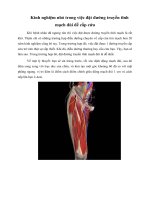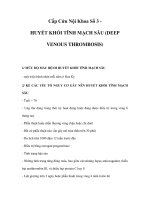Dịch truyền tĩnh mạch – Sẽ đi đâu sau truyền 1h - Professor Brendan Smith
Bạn đang xem bản rút gọn của tài liệu. Xem và tải ngay bản đầy đủ của tài liệu tại đây (3.2 MB, 55 trang )
<span class='text_page_counter'>(1)</span><div class='page_container' data-page=1>
<b>IV Fluid –</b>
<b>Where Will It Be One Hour From Now?</b>
<b>Professor Brendan Smith .</b>
School of Biomedical Science, Charles Sturt University,
Medical School, University of Notre Dame, Australia,
</div>
<span class='text_page_counter'>(2)</span><div class='page_container' data-page=2>
Choose a number between 1 and 36.
Remember your number…
</div>
<span class='text_page_counter'>(3)</span><div class='page_container' data-page=3>
iv fluid is used in every hospital on earth every day!
</div>
<span class='text_page_counter'>(4)</span><div class='page_container' data-page=4></div>
<span class='text_page_counter'>(5)</span><div class='page_container' data-page=5></div>
<span class='text_page_counter'>(6)</span><div class='page_container' data-page=6>
But does it have to be intravenous
fluid?
What about
<b>oral</b>
</div>
<span class='text_page_counter'>(7)</span><div class='page_container' data-page=7>
Dr Thomas Latta
– Scotland – 1832
(Cholera epidemic)
1 ounce = 30ml
</div>
<span class='text_page_counter'>(8)</span><div class='page_container' data-page=8>
Dr Thomas Latta
– Scotland – 1832
(Cholera epidemic)
1 ounce = 30ml
Six pints = 3.4 litres
</div>
<span class='text_page_counter'>(9)</span><div class='page_container' data-page=9></div>
<span class='text_page_counter'>(10)</span><div class='page_container' data-page=10>
How did we get from small volumes of
fluid to 8, 10, 15+ litres?
The average volume of blood in an adult
<b>= 5 litres</b>
The average plasma volume
<b>= 3 Litres</b>
Even if there was no plasma left, why
would we ever need more than
</div>
<span class='text_page_counter'>(11)</span><div class='page_container' data-page=11>
“Despite overwhelming data demonstrating the deleterious effects
of aggressive crystalloid-based resuscitation strategies,
large-volume resuscitations continue to be the standard of care”
<b>Bryan Cotton, Shock 2006; 26 (2): 115 - 121</b>
</div>
<span class='text_page_counter'>(12)</span><div class='page_container' data-page=12>
<i>“If giving </i>
<i>1</i>
<i>or </i>
<i>2</i>
<i>(or </i>
<i>3</i>
<i>or </i>
<i>4</i>
<i>) litres of </i>
<i>normal saline doesn’t result in a </i>
<i>sustained increase in BP or oxygen </i>
<i>delivery, why would the </i>
<i>5</i>
<i>th</i><i>or </i>
<i>6</i>
<i>th</i><i>litre give you a different result?”</i>
<b>The “Fluid</b>
</div>
<span class='text_page_counter'>(13)</span><div class='page_container' data-page=13>
<b>The curse of “fluid responsiveness”</b>
</div>
<span class='text_page_counter'>(14)</span><div class='page_container' data-page=14>
<b>The curse of “fluid responsiveness”</b>
</div>
<span class='text_page_counter'>(15)</span><div class='page_container' data-page=15>
Insert Vietnamese translation here.
</div>
<span class='text_page_counter'>(16)</span><div class='page_container' data-page=16>
Insert Vietnamese translation here.
</div>
<span class='text_page_counter'>(17)</span><div class='page_container' data-page=17>
Insert Vienamese translation here
</div>
<span class='text_page_counter'>(18)</span><div class='page_container' data-page=18>
<b>The curse of “fluid responsiveness”</b>
</div>
<span class='text_page_counter'>(19)</span><div class='page_container' data-page=19>
<b>The curse of “fluid responsiveness”</b>
Are you going to give
500ml
of crystalloid in 10 minutes
</div>
<span class='text_page_counter'>(20)</span><div class='page_container' data-page=20></div>
<span class='text_page_counter'>(21)</span><div class='page_container' data-page=21>
Are clinical signs reliable indicators
of response to fluid?
It depends on their
sensitivity to change
,
and
on the
measurement error
of the method …
If the measurement error is large, e.g.
30%
then the change has to exceed
<b>at least 30%</b>
</div>
<span class='text_page_counter'>(22)</span><div class='page_container' data-page=22>
Can you measure a hair
accurately using a ruler?
</div>
<span class='text_page_counter'>(23)</span><div class='page_container' data-page=23>
<b>Sensitivity to Change</b>
Would you dose medication
using these scales?
</div>
<span class='text_page_counter'>(24)</span><div class='page_container' data-page=24>
<b>Sensitivity to Change after Fluid Bolus</b>
<b>BP</b>
<b>Pulse Pressure </b>
(BPsystolic – BPdiastolic)
<b>Heart Rate</b>
What about <b>Cardiac Output </b>and <b>Stroke Volume?</b>
<b>Measurement Error of Methods</b>
Swan-Ganz <b>20 - 30%</b>
PiCCO <b>20 - 40%</b>
NiCOM (Cheetah) <b>25 - 45%</b>
ICG <b>30 - 70%</b>
15%
minimum<b>∆</b>
to be reliable
Any
clinical
</div>
<span class='text_page_counter'>(25)</span><div class='page_container' data-page=25>
<b>Sensitivity to Change after Fluid Bolus</b>
Echocardiography / Doppler
<b>Measurement Error </b>
=
<b>3 – 10%</b>
</div>
<span class='text_page_counter'>(26)</span><div class='page_container' data-page=26>
We give the patient 10ml/kg of fluid
The patient responds to the fluid.
</div>
<span class='text_page_counter'>(27)</span><div class='page_container' data-page=27>
<b>Starling Curves and Fluid Loading</b>
<b>Stroke </b>
<b>Volume</b>
<b>LVEDV</b>
Healthy
Mild
Heart
Failure
20%
8%
5%
2%
</div>
<span class='text_page_counter'>(28)</span><div class='page_container' data-page=28>
So if the patient responded then
a second bolus will
<b>overload</b>
them!
If the patient was not responsive then
one bolus
<b>may not be enough loading</b>
!
So how did knowing that the patient was
</div>
<span class='text_page_counter'>(29)</span><div class='page_container' data-page=29>
Maybe use a smaller challenge volume…
</div>
<span class='text_page_counter'>(30)</span><div class='page_container' data-page=30>
<b>Starling Curves and Fluid Loading</b>
<b>Stroke </b>
<b>Volume</b>
<b>LVEDV</b>
Healthy
Heart
Failure
8%
~3%
</div>
<span class='text_page_counter'>(31)</span><div class='page_container' data-page=31>
If the
<b>minimum detectable change </b>
is
<b>15% </b>
for BP / P
ulseP
ressure/ HR
there may be
<b>no detectable response</b>
even in a healthy patient!
And…
</div>
<span class='text_page_counter'>(32)</span><div class='page_container' data-page=32>
“If the patient is fluid responsive
then we can give fluid…”
<b>But why?</b>
<b>Responsiveness</b>
is not the same as
</div>
<span class='text_page_counter'>(33)</span><div class='page_container' data-page=33>
All of us in this room
<b>would respond </b>
to a fluid bolus…
but how many of us
<b>need</b>
one?
<b>None!</b>
Although one of these would be good…
</div>
<span class='text_page_counter'>(34)</span><div class='page_container' data-page=34></div>
<span class='text_page_counter'>(35)</span><div class='page_container' data-page=35>
The reason we use a fluid bolus is…
To increase <b>Stroke Volume</b>
This leads to increased <b>Cardiac Output</b>
Which improves <b>Perfusion</b>
Which increases <b>Oxygen Delivery (DO<sub>2</sub>)!</b>
<b>But does it?</b>
</div>
<span class='text_page_counter'>(36)</span><div class='page_container' data-page=36>
We can define
<b>need</b>
easily:
It is the need for an increase in
tissue perfusion
and in
tissue oxygenation
(as measured by an increase in
tissue oxygen tension – PtO
<sub>2</sub>)
Does anybody measure PtO
<sub>2</sub>?
But what about
duration
30 mins
?
1 hour
?
</div>
<span class='text_page_counter'>(37)</span><div class='page_container' data-page=37>
<b>DO</b>
<b><sub>2</sub></b>= 1.34 x [Hb] x SaO
<sub>2</sub>x CO
100
If fluid increases <b>CO</b> then this looks good but…
Fluid reduces haemoglobin concentration
which <b>reduces DO<sub>2</sub></b>.
1L of fluid reduces <b>[Hb] </b>by ~ <b>20%</b>.
But how much does <b>CO</b> increase?
If
<b>↑CO </b>
<20%
then we make a loss on the deal,</div>
<span class='text_page_counter'>(38)</span><div class='page_container' data-page=38>
The average increase in CO
in response to 1L of fluid is –
<b>11% </b>
</div>
<span class='text_page_counter'>(39)</span><div class='page_container' data-page=39>
How many patients are fluid responsive?
Multiple (171) studies have consistently shown
only <b>50%</b> or less of haemodynamically
unstable patients are fluid responsive!
Therefore <b>50%</b> of patients given a fluid bolus
immediately have <b>reduced DO<sub>2</sub></b>,
i.e. they are directly harmed.
Of patients <i><b>who do respond </b></i>to fluid
only <b>50%</b> increase <b>CO</b> by <b>=>20%</b>
</div>
<span class='text_page_counter'>(40)</span><div class='page_container' data-page=40></div>
<span class='text_page_counter'>(41)</span><div class='page_container' data-page=41>
<b>80%</b>
of a crytalloid bolus is
extravascular by
<b>60</b>
minutes…
And that’s on a good day!
CHEST 2015; 1 48 ( 4 ): 919- 926
(
<b>FACTT</b>
)
</div>
<span class='text_page_counter'>(42)</span><div class='page_container' data-page=42>
<b>569</b> Fluid bolus doses in <b>127</b> patients
(for low BP, low urine output, or both)
Only <b>23%</b> of patients showed CO increase =><b>15%</b>
Mean increase in MAP at 1 hour = <b>2mmHg</b>
<b>No change </b>in urine output.
<b>94%</b> had <b>reduced tissue oxygenation </b>at <b>1 hour</b>.
</div>
<span class='text_page_counter'>(43)</span><div class='page_container' data-page=43></div>
<span class='text_page_counter'>(44)</span><div class='page_container' data-page=44>
“Results show that volume expansion with crystalloids
in patients with circulatory shock has limited success
even in (volume) responders.”
<b>MAP increased by 2.9mmHg (3.9%)</b>
<b>[Hb] decreased from 95.9 g/L 91.1g/L (5%)</b>
</div>
<span class='text_page_counter'>(45)</span><div class='page_container' data-page=45>
<b>Cardiac Index (L/min/m2<sub>) over 45 mins</sub></b>
“Responders” - <b>2.9 </b>L/min, <b>3.55</b> L/min, <b>3.1</b> L/min, <b>3.0 </b>L/min
Non-responders - <b>3.4 </b>L/min, <b>3.6</b> L/min, <b>3.3 </b>L/min, <b>3.2 </b>L/min
<b>0</b> <b>15</b> <b>30</b> <b>45 mins</b>
</div>
<span class='text_page_counter'>(46)</span><div class='page_container' data-page=46>
<b>26</b> Post-op patients
<b>250ml</b> crystalloid rapidly
<b>50%</b> responders
Maximal <b>CO</b> at <b>1.2 minutes </b>post challenge
<b>CO</b> returned to baseline by <b>10 minutes</b>
</div>
<span class='text_page_counter'>(47)</span><div class='page_container' data-page=47></div>
<span class='text_page_counter'>(48)</span><div class='page_container' data-page=48>
<b>Septic Shock Patients are </b>
<b>NOT</b>
<b>Volume Depleted </b>(usually)
</div>
<span class='text_page_counter'>(49)</span><div class='page_container' data-page=49>
The 7 questions we need to ask
<b>before</b>
giving an iv fluid bolus:
1. Is there clear evidence of inadequate tissue perfusion?
2. Is there clear evidence of inadequate preload?
3. Is it clear why preload is inadequate?
4. Is there evidence of impaired cardiac function?
5. Was there a positive response to PLR?
</div>
<span class='text_page_counter'>(50)</span><div class='page_container' data-page=50></div>
<span class='text_page_counter'>(51)</span><div class='page_container' data-page=51>
<b>Conclusion:</b>
Taking all the research together, the number of
haemodynamically unstable patients treated with a
fluid bolus who still show an increase in DO<sub>2</sub> and
tissue oxygenation after 1 hour is…
<b>2.7%</b>
<b>Or about </b>
<b>1 in 36!</b>
</div>
<span class='text_page_counter'>(52)</span><div class='page_container' data-page=52></div>
<span class='text_page_counter'>(53)</span><div class='page_container' data-page=53>
And our lucky patient today is…
<b># 17</b>
</div>
<span class='text_page_counter'>(54)</span><div class='page_container' data-page=54>
But if anybody wants to know more about
fluid responsiveness then join me later and
</div>
<span class='text_page_counter'>(55)</span><div class='page_container' data-page=55></div>
<!--links-->









